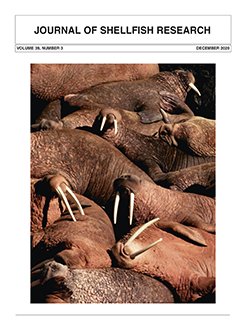The goal of this study was to evaluate the efficacy of phenotypic traits and two genetic assays to distinguish between Mercenaria mercenaria, an important aquaculture species, and Mercenaria campechiensis, a conspecific species that is partially sympatric, but that has not been successfully farmed. The objectives were to evaluate (1) four established diagnostic phenotypic traits (lunule shape, thickness of concentric shell ridges, prominence of anterior side of the concentric ridges, and presence of purple nacre inside of the shells) to distinguish between species, (2) size polymorphism of PCR fragments from four genes [16S rRNA, 18S rRNA, Internal Transcribed Spacer genes (ITS1 and ITS2)], and (3) PCR-restriction fragment length polymorphism (RFLP) on three of these genes (16S, ITS1, and ITS2). Phenotypic traits correctly distinguished two geographically distant conspecific populations (two locations in Maine for M. mercenaria and in Bradenton, FL, for M. campechiensis); however, among all other locations, both species had overlapping phenotypic trait values. Although PCR fragments were obtained for all genes tested, size polymorphism was not identified between the two species. Restriction enzyme digestion of PCR fragments resulted in diagnostic fragments distinguishing the two species for 16S, ITS1, and ITS2. Although phenotypic scores failed to delineate between the two species in most locations, PCR-RFLP results failed to identify hybrids in wild or hatchery samples. Further investigation is needed to apply the PCR-RFLP assays on known hybrid offspring from crosses of M. mercenaria and M. campechiensis. Results have elucidated the difficulties in confidently detecting hybridization in quahogs; however, determining effective methods for species identification and hybrid detection will be important to address issues such as the prevalence and distribution of hybridization in aquaculture and in wild populations, and to determin the presence of M. campechiensis which are currently difficult to find.
How to translate text using browser tools
28 December 2020
Phenotypic and Genetic Identification of Mercenaria mercenaria, Mercenaria campechiensis, and Their Hybrids
Erangi J. Heekenda,
James D. Austin,
Zhe Zhang,
Huiping Yang
ACCESS THE FULL ARTICLE

Journal of Shellfish Research
Vol. 39 • No. 3
December 2020
Vol. 39 • No. 3
December 2020
Mercenaria campechiensis
Mercenaria mercenaria
Northern quahog
PCR-RFLP
phenotypic score
southern quahog
species identification




